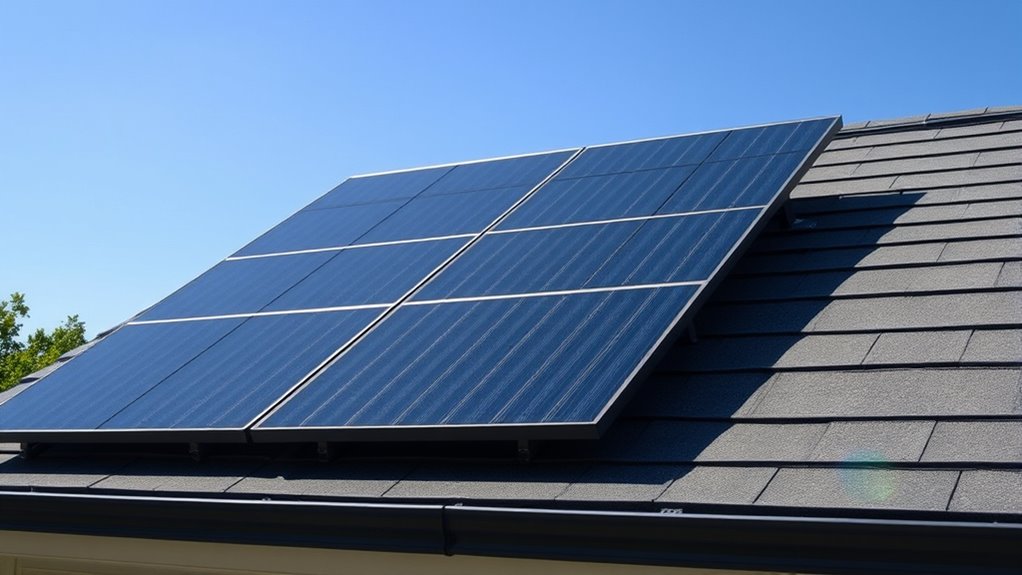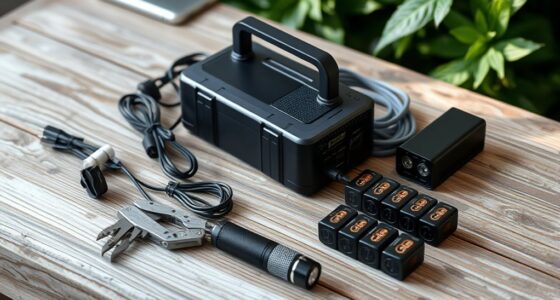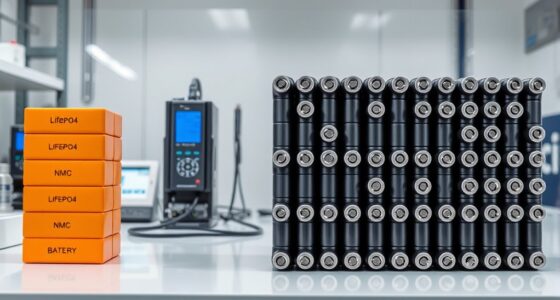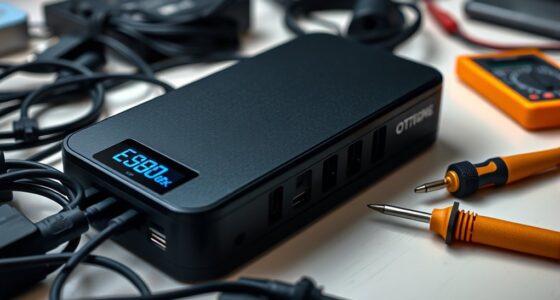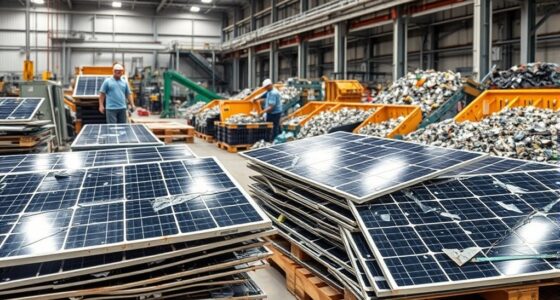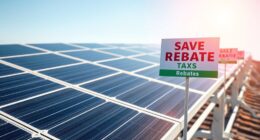Bifacial solar panels can boost your energy production since they capture sunlight from both sides, making them more efficient, especially in reflective environments. However, they typically cost more upfront and need specialized mounting, which can increase installation expenses. Their performance depends heavily on your roof’s orientation and shading. While they offer long-term savings, evaluating these factors helps determine if they’re right for your home. Exploring more details will help you understand if they’re a smart investment for you.
Key Takeaways
- Bifacial panels can generate more energy by capturing sunlight on both sides, increasing overall power output for home installations.
- Higher initial costs and specialized mounting systems may extend the payback period and increase installation expenses.
- They perform best in environments with reflective surfaces like snow or light-colored roofs, maximizing energy gains.
- Proper site assessment is essential, as shading and roof orientation significantly impact their efficiency and benefits.
- Suitable for homes with optimal environmental conditions; consulting solar professionals helps determine if bifacial panels are a good investment.
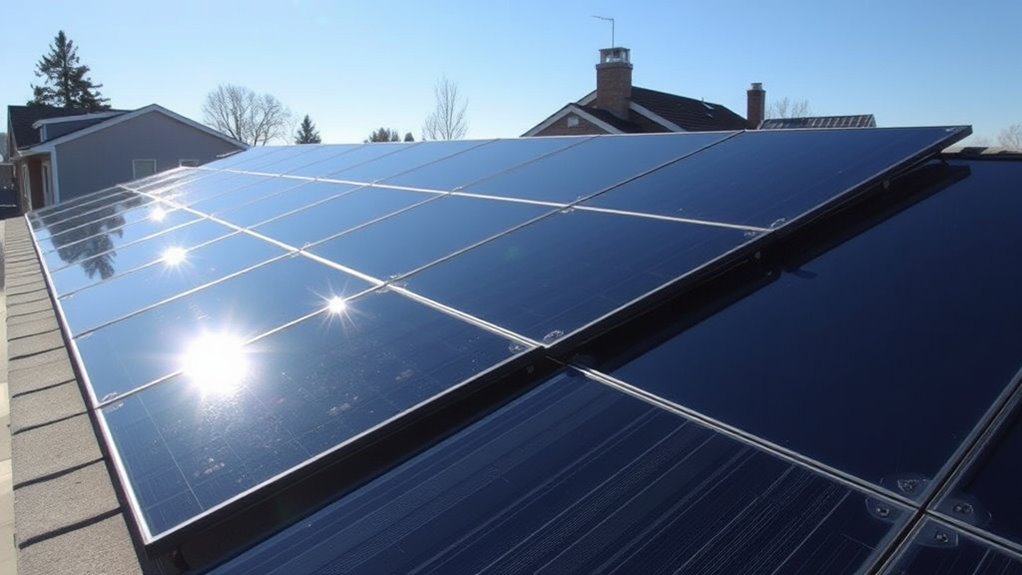
Bifacial solar panels are gaining popularity for home use because they can capture sunlight on both sides, increasing energy production. This dual-sided design means you can generate more power from the same footprint, making them an attractive option for maximizing your roof’s potential. However, before jumping in, it’s important to contemplate the cost efficiency and installation challenges associated with these panels. While bifacial panels can offer higher energy yields over time, their initial costs are typically higher than traditional monofacial panels. The premium price reflects their advanced technology and the potential for greater output, but it also means you need to evaluate whether the increased energy production justifies the investment. In some cases, the payback period may be longer, especially if your location doesn’t receive abundant sunlight or if shading issues limit their effectiveness.
Installation can present unique challenges when working with bifacial panels. Unlike standard solar panels, they often require specific mounting systems that allow sunlight to reach both sides of the panel efficiently. You might need specialized racking, which can be more expensive and complex to install. The installation process also demands careful planning to optimize the panels’ tilt and orientation, ensuring that both sides receive maximum sunlight throughout the day. Additionally, since bifacial panels are generally mounted higher above the roof surface to facilitate light capture from underneath, this can lead to increased labor and material costs. Properly considering environmental factors is crucial for maximizing their performance. You’ll want to work with experienced installers familiar with bifacial systems to avoid potential setbacks and ensure proper setup.
Despite these challenges, bifacial solar panels can be a smart investment if you have the right conditions. They tend to perform better in environments with reflective surfaces like snow, sand, or light-colored rooftops, which bounce sunlight onto the backside of the panels. If your home’s roof faces the right direction and has minimal shading, you could see a significant boost in energy generation. Keep in mind, though, that the higher upfront costs and installation complexities might mean a longer wait until you start seeing financial benefits. It’s essential to weigh these factors carefully and consult with solar professionals who understand bifacial technology to determine if it’s the right fit for your home. Ultimately, while they can be more demanding to install and more expensive initially, bifacial panels have the potential to deliver increased savings and energy efficiency over their lifespan.
Frequently Asked Questions
How Do Bifacial Panels Perform in Cloudy or Shaded Conditions?
Bifacial panels perform reasonably well in cloudy or shaded conditions because they capture diffuse light from the sky and reflected sunlight, boosting energy production. While shading effects reduce their efficiency, their ability to utilize light from both sides helps compensate. You’ll notice some decrease in output during overcast days, but overall, bifacial panels tend to generate more energy than traditional monofacial ones in shaded or cloudy environments.
What Maintenance Is Required for Bifacial Solar Panels?
You should regularly clean your bifacial solar panels using gentle cleaning routines to remove dirt and debris that can reduce efficiency. Inspect the panels periodically for damage, such as cracks or dirt buildup, especially on the back side where sunlight reflects. Keep the area around the panels clear of obstructions, and ensure mounting hardware stays secure. Proper maintenance maximizes energy output and prolongs the lifespan of your bifacial solar system.
Are Bifacial Panels Compatible With Existing Home Solar Systems?
Yes, bifacial panels are compatible with your existing home solar system, but you might need to adjust your panel installation to maximize their benefits. Check if your inverter can handle the increased energy output and guarantee your mounting system allows for proper reflection and sunlight exposure. Consulting a solar professional ensures system compatibility, ideal performance, and seamless integration with your current setup.
How Does the Cost of Bifacial Panels Compare to Monofacial Panels?
Bifacial panels generally cost more than monofacial panels, with the price difference often ranging from 10% to 30%. The cost comparison shows that while bifacial panels have a higher upfront price, they can generate more energy over time, potentially offsetting the initial investment. You should consider the long-term savings and energy yield when evaluating whether the higher price of bifacial panels is worthwhile for your home.
What Is the Typical Lifespan of Bifacial Solar Panels?
Imagine you’re stepping into the future, just like Marty McFly with your bifacial solar panels. Typically, these panels last around 25 to 30 years, thanks to their excellent panel durability. You can count on their warranty coverage to protect against defects and performance loss. With proper maintenance, you’ll enjoy reliable energy production for decades, making them a smart long-term investment for your home.
Conclusion
Considering the pros and cons, bifacial solar panels can boost your home’s energy output—up to 25% more than traditional panels, according to recent studies. They’re a smart choice if you have reflective surfaces or ample space, but they come with higher upfront costs and potential shading issues. Weighing these factors helps you decide if their efficiency gains align with your budget and home environment, making bifacial panels a promising, yet nuanced, solar option.
